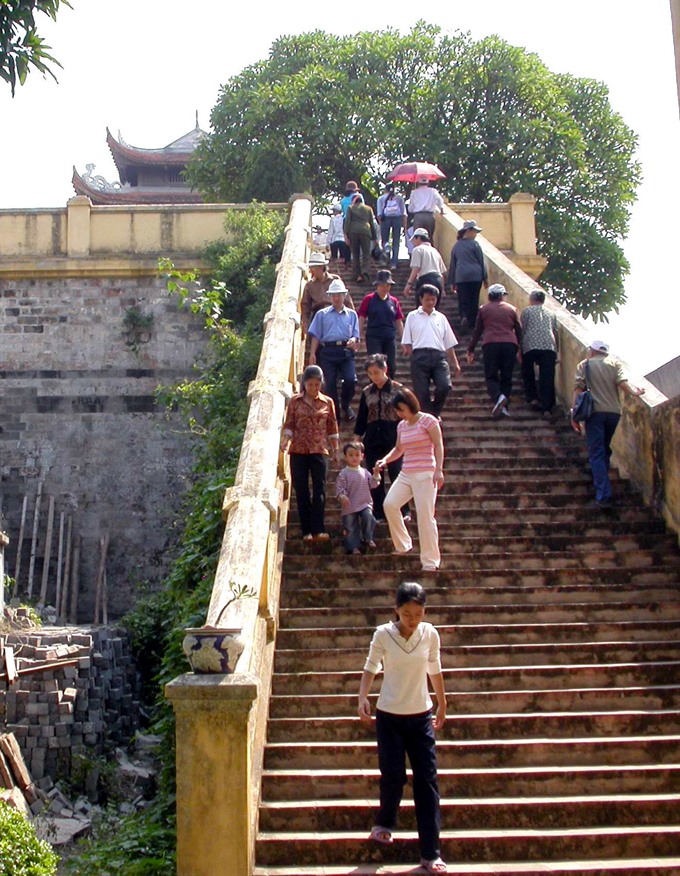 Society
Society

Trần Minh Nguyệt, 22, a backpacker from HCM City, experienced her first trip to Hà Nội early this month.
 |
| Tourists visit the Thăng Long Imperial Citadel. — VNS Photo Đoàn Tùng |
HÀ NỘI — Trần Minh Nguyệt, 22, a backpacker from HCM City, experienced her first trip to Hà Nội early this month.
Nguyệt said her smartphone was the one thing she could not live without during her three-day trip to Hà Nội.
It helped her search for restaurants and hotels, book tickets and get information from applications about must-see destinations in the 1000-year-old capital.
Nguyệt is one of the countless tourists using applications and smartphones for their travelling purposes around the country and the world.
Developing smart tourism is believed to be an inevitable trend not only to serve demand but also to catch up with the rest of the world, the Hà Nội Mới (New Hà Nội) newspaper reported.
To catch up with this trend, some destinations in Hà Nội have built their own applications or applied technology to serve the demands of tourists.
For example, Văn Miếu – Quốc Tử Giám Scientific and Cultural Activities Centre is a pioneer in providing audio guides for tourists in Vietnamese, English, French, Korean, Japanese, Thai and Chinese.
A tourist has to buy a ticket to use the service; it costs VNĐ30,000 (US$1.3) in Vietnamese and VNĐ50,000 ($2) in a foreign language.
Meanwhile, the Conservation Centre of Thăng Long - Hà Nội launched a mobile application called Hoàng Thành Thăng Long in January to give tourists free guides to the Thăng Long Imperial Citadel. People can open Play Store or App Store on their smartphones and search for “Hoàng Thành Thăng Long” to download the application. The free application is presented in Vietnamese, English and Japanese. French and Chinese will be added soon.
The administration of Hoàn Kiếm District has a website, https://hoankiem360.vn/, to provide tourists information about where to go, what to eat and where to stay in the district. The website is presented in both Vietnamese and English.
However, not all places in Hà Nội have been able to launch a mobile application or run a website to better serve tourists.
Nguyễn Thị Thuỷ, of Cổ Loa Historical Site Management Board in Đông Anh District, said she struggled with how to attract more tourists to the site.
The management board had yet to run a mobile application or a modern website to lure tourists, she said.
Việt Nam National Museum of Fine Arts faces a similar situation.
Nguyễn Thu Thuỷ, head of Science and Service Company, said when she was invited to consult at the Việt Nam National Museum of Fine Arts, the first thing she wanted them do was add an automatic audio guide.
She said this could help the museum lure more tourists. At present, it welcomes fewer people than expected.
According to Thuỷ, tour guides were often afraid to take tourists to the museum because the guides did not know much about art.
It was necessary to introduce an automatic audio guide system soon, she said.
Deputy President of the Việt Nam Tourism Association Vũ Thế Bình said smart tourism would help people access information as quickly as possible.
To fully integrate smart tourism, the city must have adequate technical infrastructure, he said.
The city’s Tourism Department has co-operated with the Information and Communication Department to install 36 free Wi-Fi hotspots around Hoàn Kiếm Lake and in nearby areas.
The administration had also introduced a plan to turn the city into a smart city in the near future, Bình said.
A representative of the tourism department said it had worked with relevant agencies to boost the speed of developing smart tourism.
Bình said building smart tourism is one goal of the city’s target programme of applying information technology in State agencies for 2016 to 2020.
To achieve the target, he said the city would need a consensus of the local people.
In a letter sent to Hà Nội Mới (New Hà Nội) newspaper, reader Dục Tú said developing smart tourism was not an easy process. It required a shift in both awareness and action.
Developing smart tourism not only depended on applying technology but also on the quality of service, he said.
He added that it demanded the consensus of the administration, relevant agencies and local people. — VNS